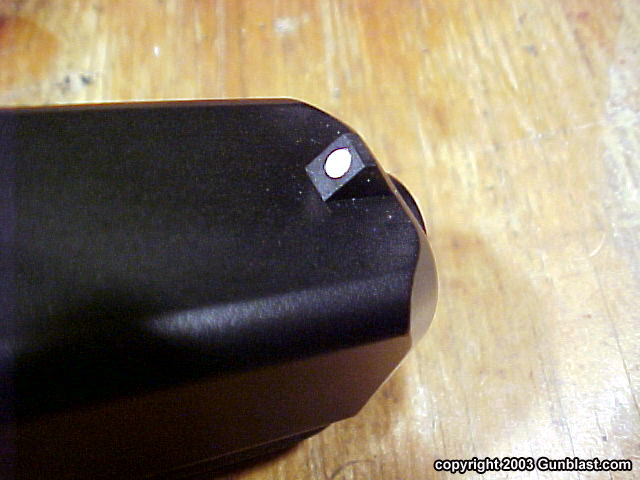
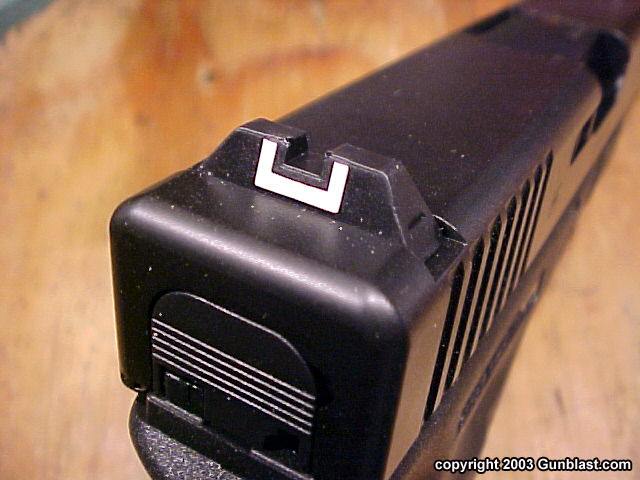
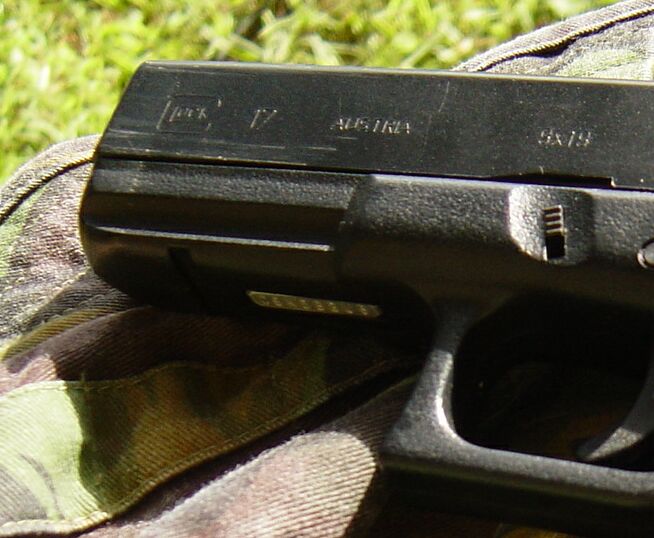
| |
KSC |
Glock |
|
Length (slide) |
184mm |
186mm |
|
Height |
135mm |
138mm |
|
Width |
30.5mm |
30mm |
|
Length between sights |
170mm |
171mm |
|
Barrel length |
85mm |
114mm |
|
Empty, no magazine |
400g |
680g |
|
Empty magazine |
320g |
78g |
|
Full magazine |
~325g |
~280g |
As you can see from the above table, the replica and original are on the whole, quite close in dimensions.
Impressions
and Visuals
This was my very first
airsoft gun, so I was not quite sure what to expect. It looked and felt
similar to the real thing. A bit lighter though, as the real Glock 17
has a metal slide (unlike this KSC model) and the magazine, once filled
with ammunition, adds to the heft. The ‘feel’ of the real polymer
though, is closest matched with the KSC Glock 26, as the Glock 17/18c
looks too plasticy, and the G19 looks too ‘green’ and dull. This is a
copy of Glock's 3rd Generation Glock 17, with the 1st
and 2nd Generations not having a rail molded into the lower
front frame. Newer KSC Glock 17s are coming out with a coating over the
plastic, that makes them appear as though they are using the
same frame ABS as on their Glock 19. It is easily scratched off
unfortunately. For those of you who really like to have lots of metal
parts showing, or in contact with your hands when operating an airsoft
gun, you will be disappointed with the Glock as it only has a metal
slide release. The externally, the rest is plastic ABS as befits a
replica of the polymer-framed pistol.
With Glock insignia on the nose, grip, base of magazine, and serial number at base of front frame, the KSC Glock would be hard pressed to not be mistaken as a real gun. On the chamber slide is a serial number which is in the right spot and a cartridge extractor, (which is just a mold on the slide-frame) just behind it. One thing that this Glock does not have that all other KSC Glocks that I have seen (G18c, G19, G26), has been the little Glock ‘eagle’ and little NPV logo. On the real gun, there are the markings to indicate that the gun has been through 2x or 3x load (bullet propellant) testing.
On the right hand side of the frame, top of grip, are the words "MADE IN AUSTRIA", "GLOCK. INC.. SMYRNA. GA.". According to various people, the Taiwan version of this Glock will have "Made in Taiwan" underneath the "MADE IN AUSTRIA" plate, but apparently some people with Japan versions of the KSC G17, have had "Made in Taiwan" appear in the same place. On the right grip, near the base, there is a US Patent number, which I will not replicate here.
The Sights are standard Glock
"U" shaped rear, and white dot front sight. Like the real Glock, the
rear fits into a dovetail grove. Unlike the real Glock, the rear sight
can be moved rather easily from side to side. After plenty of
skirmishing over a year, I finally had the fortune to knock my rear
sight out, somewhere on a field. I say fortune, as the real sights will
fit quite nicely. I took the opportunity to purchase an adjustable rear
sight, which (once affixed in place) will do nicely for some time to
come. The adjustable rear takes away the uncertainty of trying to tap
your rear sight into the correct position, and is also able to be
adjusted for height too.
The Slide is (as
mentioned above) made of plastic, and so is the recoil guide.
Apparently with earlier model KSC G17s there was a tendency for the
front of the slide to crack or break; owing to the forces being applied
to the corners. This has not happened to my version owing to a metal
support frame being applied to the front inside of the slide, allowing
the forces to be distributed further along the slide. At the end of the
recoil guide (end slotting into the slide), was a rubber damper
(washer) which further aided in damping of forces. This, I see, has
been further enhanced in today’s model, with greater thickness and a
different shaped applied to today’s dampers. Please take note in
the picture of the marks at the front end of the slide.
Recoil with the stock
spring can seem a bit slow. But now there is a GuayGuay
‘Bright Titanium’ rod in-place, with a slightly stiffer spring,
there is a far nicer ‘slap’ to it when firing and a nicer ‘tension’
when
pulling the slide back to chamber a round.
The
Trigger is a copy of Glock’s trigger safety, and is part one of the
three parts of Glock’s Safe Action System. The other two are the
"firing pin safety" and the "drop safety", which are not presently
incorporated into the KSC replica. KSC has added a safety of their own
to their pistol, in the form of the trigger safety, which can be gently
prised up and out of the trigger, and creating something rather
unpleasant to try to squeeze.

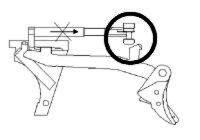
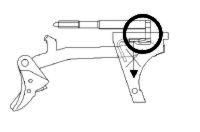
Trigger
Safety
Firing Pin
Safety
Drop Safety
Stripping
- The Glock that is.
Identical to the real gun. Pull down
simultaneously the two little levers, located in the frame and above
the trigger. Pull the slide back slightly, and then all the way forward
and off of the frame. Next, pull out the guide rod and spring, and then
pull out the outer barrel. That is it. Easy.
This is a real
Glock 17. You can tell by the spring, and the underside of the
slide. This guide was used as it is identical to fieldstripping the KSC
Glock 17.
Click on Image.
Power
ET1000: 336fps with a high of 340.
HFC134a: 272fps
Not much to say with this. The chrono used
was a F1 Chrony, tested indoors, using Maruzen .2s. The results are an
average with both gases. Temperature was approximately 25*C.
Accuracy
It should be noted that I have a tendency to ‘push’ (anticipating the recoil) to the left a bit. The light was not of much help too, as it was light at the target end, but not at mine. Excuses, I realise, but they illustrate that at the moment, the KSC Glock 17 is not being pushed by my capabilities. I have made a slight modification to the outside of the inner barrel, to try to negate the infamous ‘KSC Left Hook’, which seems to have worked for the most part – particularly on the skirmish field.
To assist with ‘reading’ the target on the right, the distances are:
A -> F: 46mm
A -> E: 33mm
B -> E: 20mm
D -> E: 15mm
D ->B: 12mm
The target on the right is more
consistent with my usual accuracy, but I have seen better groupings
with the Glock. Distance of 10m+ can be also quite good for apparent
groupings as well, but this was not quantified at any point, merely
that it was consistently close to a very visible target point. It may
also be that my better groupings were of when I was using Maruzen .25s,
and the weight was contributing towards improved accuracy. When I will
do some serious target shooting with this, I am tempted to use .3s or
.29s. In short, this gun is a good tool for furthering my own
capabilities.
"Move it to the
left"
Like a lot of KSC guns that I have
handled, this model also exhibited the "KSC Hook": The bbs start
curving away to the left after about 20m. I have performed a partial
fix to this by cutting some small strips of insulation tape and placing
them on the leftside -outside of the inner barrel near the o-ring. This
is merely creating a slight spacer, as the outer barrel (inside) at
that point may not be perfectly round, therefore letting the o-ringed
inner barrel have some lateral movement during the firing cycle.
Tanio Koba Twist Barrel.
I have recently acquired one of these uncommon (in the Western Hemisphere) Twist Barrels for the Glock 17, but have not made much effort into properly installing, checking and testing to see if such a system is actually worthwhile. The reason for this is that my present modification is working quite well, and I am reluctant to disturb the system. In saying that though, I have recently installed a new hop-up rubber into the Glock 17, which seems to have improved the accuracy.
Skirmishing and
use.
My holster of choice
for this is a Fobus model, that is a snug fit and has 100% prevented
any hitting of the magazine release button, and dropping the magazine
in a place I will never find it again. The only downside that has been
found so far with it, is that the plastic slide is getting some
scratches along the front half of it, probably also owing to the fact
that it is marginally wider (0.5mm!) than a real Glock.
The magazine release
is something that can and will wear away with use. This was probably
accelerated with more than reasonable use of the extended magazine. The
plastic itself is a very light ‘feel’ that is easy to scratch, and,
where the plastic catches into the ‘cut’ in the magazine, wears
reasonably fast too. Mind you, this is over ¾ of a years skirmishing.
How I was able to determine that it was time to replace the magazine
catch for the Glock, was when I was firing, and, owing to the shock
from the blowback/recoil, the magazine would fall straight out from the
well.
Having looked at www.glockfaq.com previously, and noting the similarity of the magazine release catch, I took a punt on purchasing the appropriate real Glock part. The correct part that conforms to KSC’s size is Part#287, but with none of those in stock at the shop, I risked getting the extended magazine release (Part#1981). This has turned out to be an excellent choice for me, as it is easier for my thumb to come into contact, therefore releasing the magazine when I need to.
The selection of the real magazine release, though, was not entirely bug-free. It was noted that when firing that the slide would not completely return to battery. Initially I suspected that the recoil spring was too weak, or that the springs inside the slide (KSC part#23) were to blame. It was pointed out to me though, that with the ‘improved’ magazine release, the magazine was being held up marginally higher in the frame, with part of the top rubbing against the base of the inside of the slide. Simple to fix. All that is required to do is sand off a small fraction of the plastic release, where it catches into the notch on the right side of the magazine.
One of the first things that got worn
away on this KSC was the rubber buffer, where the recoil guide is
inserted into the slide. The buffer on my model was a thin rubber
washer- shaped, whereas the newer models appear to be coming through
with a thicker buffer that extends from the base of the recoil rod to
the base of the outer barrel.
The guide rod itself stood
up
well, with no fractures appearing, or any indication of an imminent
break. As mentioned earlier, I thought (mistakenly as it turned out),
that the spring on it was
wearing out,so it was then time to purchase to metal rods and springs
from Wargameclub Shop;
the Zenith
and the G&G.
After receiving them both, I
installed the shiny one first (G&G).
It has made the 'racking action' a bit closer to that of a real gun,
and looks clean
when the slide is locked back. The Zenith on the other hand was not so
good. The first noticeable problem (to me) was how much rougher it was
when the spring is moving along the rod. Upon disassembling the Zenith
guide, it becomes more apparent that the rod itself appears to be 3/4
finished. Quite visible is the rather large ‘seam’ line running the
length of the rod, which makes the feel of ‘racking’ not smooth. Both
of the new springs have a higher compression than the OEM guide rod,
with the Zenith having noticeably more compression again than the
G&G. This is not a bad thing, merely that I suspect that it would
be better used in summer times, or in upgraded Glocks. The G&G
(bright titanium) is my recoil guide of choice.
For those of you who wish to add something of more comfort, or just
to make it look more "tactical-like", I have recently added an
Uncle Mike grip to it. It has transformed the 'feel' quite
considerably, with the pointability of the Glock being improved.
Quite comfortable as well.
BB
Selection
Even though the most common bb used in
skirmish is .2g, the weight of bb that I have found to be best so far
has been the .25g. The reason? So that the actually trajectory of the
bb is less affected by such factors as wind, rain, and the occasional
grass and bush. The trade off in range, for me, is made up in greater
consistency of shot placement, which is a plus. The .25s are also a
better weight for when shooting at targets, but I would like to try a
few hundred rounds of .29s and .36s as the range is definitely not as
important when firing at 15m or less. As mentioned earlier, the KSC
.25s which came included in the box I didn’t think went very well in
this. This may have been due to the use of HFC134a though. The next bbs
used were probably 1000rds of Tokyo Marui .2s of which I have no
recollection of how ‘good’ or ‘bad’ they were. Excel .2s in a bag of
3700 were the next diet of this Glock, of which I didn’t think too much
of – owing to feeding issues. The best ones that have gone through this
(so far) have been the Maruzen .25s and .2s, and the Tokyo Marui .25s.
Now to get those .29s and .36s!
Care
and Maintenance
There is not much that is required to keep this running.
I ran 1000 rounds through the G17 before I even thought about getting
some
lube for it, and even then, it was only because it started to bind up a
bit upon returning to battery. The areas that I feel that need
lubing
are: The magazine valves, the gas packing on top of the magazine, the
slide rails, the guide rod, the hammer assembly, the trigger and a little bit on the inside of the
slide - just before the chamber block, just to assist the slide motion.
Conclusion
Irregardless of anyones preferences for shape, style, feel and look,
the KSC Glock 17 is a very good starters airsoft gun. Solid,
robust, reasonable size magazines, easy to take apart to clean (if and
when they get around to doing so!), the G17 does it all. If
someone does have a liking for the Glock 17, they then have the option
to upgrade in all sorts of areas From inner and outer barrels, sights,
to rail-mounted sights. Magazine catches, extended magazines,
metal slides even down to getting aftermarket grips, to turn it from
being a skirmishable weapon, into something that could be rather
formidable in IPSC/ IDPA style competitions.
Update:
18 January 2005.
KSC has released a newer model of the G17, which has no "Glock"
trademark either on the side of the handgrips, nor on the magazine
baseplate. It also seems to have a slightly different shaped "plug"
area, located in the handgrip directly behind the magazine well. The
slide on both the newer model G17 and also the G19 series seems to be
rather fragile in the magazine catch area, with parts chipping away.
Most suprising is that all of these KSC pistols are being used in the
same environment, and with the same gases, yet the older model is still
performing better, and after firing far far more shots through it. I do
not believe this is down to care and attention, more to do with a
change of materials. Once your slide goes, feel free to upgrade to a
metal one. I will.
Another point to watch out for is probably accelerated magazine release
wear. I note that on newer models of the G23f, G19, G17 and G18c that
the catch is being warn apparently quite quickly. Once again, get
some upgraded parts as mentioned above.
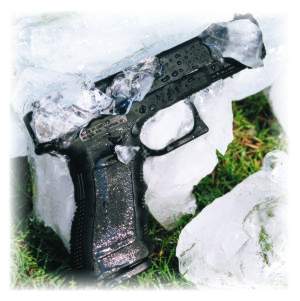
A bit more
about the Glock
The Glock 17 was created in response to the Austrian Army’s (Österreichs Bundesheer) request to for a new handgun. Up until that time, Glock was manufacturing gear of steel and plastic for them, such as "...machine gun belts, practice hand grenades, plastic clips, field knives and entrenching tools." The pistol expected to be selected was Steyr’s Model-GB, but Gaston’s design snuck in from behind, rogered the GB senseless with (Glock) reliability, and went on to win by a money shot. ("....offer was 25-percent lower than the next lowest bidder"). Norway (a NATO member) was not long behind in selecting Glock for their armed forces. The next big step was the establishment, in 1985, of a headquarters in Smyrna, Georgia, USA, and then not long afterwhich numerous law-enforcement agencies across the USA selected the Glock series for their departmental handguns.
Of course, the criminal element, taking a cue from their ‘opponent’- the local Law Authority, also took a liking to the reliable and tough Glock, and the media jumped onto the band-wagon to promote this "X-Ray proof ... plastic gun". This turned out to be a waste of time and print, by creating a false ‘urban legend’ of a "terrorist special" (which continues to this day), as the the standard Linescan television x-ray security machines at international airports could always see ‘an automatic handgun’ shape, even when field stripped and an attempt made to ‘shield’ the parts with metal objects.
Today, Glocks are made (and used) in
a variety of countries around the world, with an assortment of calibers
ranging from the 9x19mm round, the .40, .380, through to the new 45GAP
(Glock Automatic Pistol) which was created especially for and fired
from the new Glock 37.
Links
http://www.glock.com/g17.htm - The home of Glock
http://www.glockfaq.com/ - A
rather large resource area for Glock information, guides and images.
http://www.topglock.com/info/fieldstrip.htm
- for the very good images of how to fieldstrip
Glocks, not authorised, but thank you.
http://remtek.com/arms/glock/model/9/17/index.htm
- A good resource for Glock 17
http://www.gunblast.com/ - where
I got the images of the front and rear sights from, not
authorised. Lots of good articles. Thank you again.
Glock Parts that can be put onto the KSC replica:
Part#1981-Extended magazine catch
Part#287 - Standard magazine catch
Part#5977 - Rear sight, adjustable
Part#224 - Front sight
Part#182 - Rear sight, fixed
These are all NON-FIRING parts, as the KSC replica
CANNOT be made into firing real ammunition